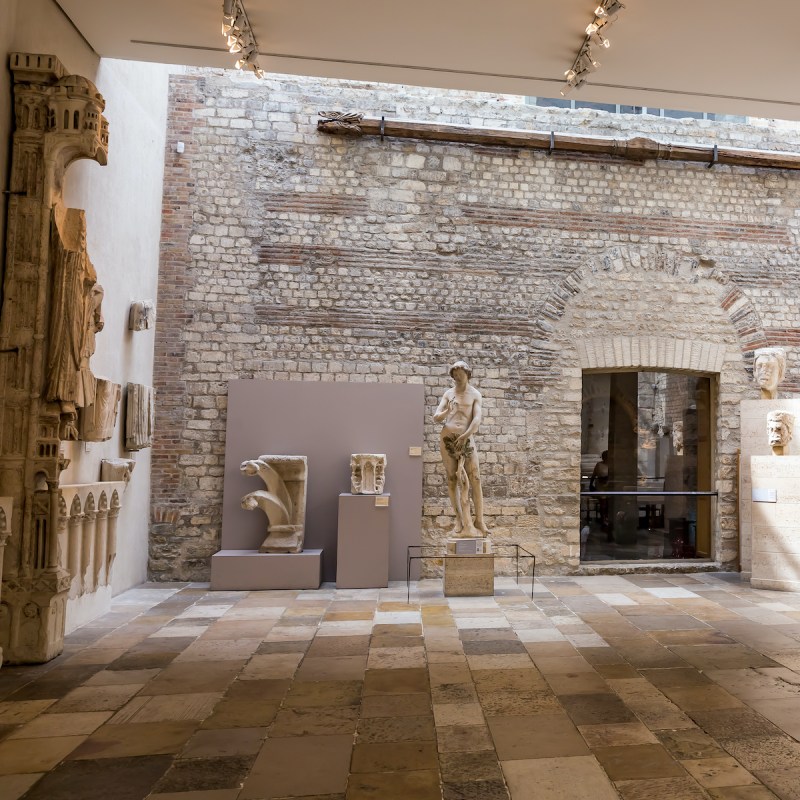
Sometimes I stand in Paris, pause, and try to imagine this city during Roman rule. My imagination goes straight to Roman baths, gods, goddesses, and gladiators. Paris was a thriving Roman city named Lutèce or Lutetia. Look around Paris today and you will find brasseries named Lutetia and a luxury hotel of the same name.
Videos by TravelAwaits
Look a little further and you will discover vestiges of this Gallo-Roman city where about
10,000 inhabitants lived. Paris was by no means a major Roman city such as Lyon or Nanterre, but the traces of this period that are found connect curious travelers and history buffs to an ancient part of Paris’s history.
Roman Paris: A Little Background About Lutetia
Long before the Romans arrived, Gallic or Celtic tribes lived by the River Seine. One tribe, calling themselves the Parisii, were the first permanent inhabitants of the area.
In 52 BCE, the Romans led by Julius Cesar invaded Gaul. The Gallic tribes banded together under their leader Vercingetorix and put up a great battle. Needless to say, the Romans won, took over the settlement, and named it Lutetia.
In classic Roman style, they built a city on a strict grid system with a main north-south axis road, the cardo maximus, which can still be found today. Lutetia had great monuments including a forum, several thermal baths, and an amphitheater. The forum and the baths were located along the main road, while the amphitheater was located just outside the city to accommodate large audiences.
In the year 308, Lutetia was fortified to protect it from barbarians. A rampart was built, made of towers and walls, making Lutetia a military town where the Roman army could set up base.
Let’s see where we can find Lutetia in modern-day Paris.

1. The Roman Amphitheater, Les Arènes De Lutèce
49 Rue Monge, 75005 Paris
The Roman Amphitheater, called the Arènes de Lutèce, is tucked away in the Latin Quarter. Enter the amphitheater, sit on one of the stone bleachers, and imagine what transpired here. Set outside Lutetia’s city limits, people flocked to the amphitheater to watch plays, animal fights, and gladiators. The Arènes de Lutèce held 15,000 to 17,000 spectators in its tiered seating. Built in the late 1st century CE, it is one of Paris’s oldest monuments.
Eventually, the amphitheater fell to ruin, and there are no signs of it on the Paris city maps from the Middle Ages.
Between 1869 and 1870 during the construction of rue Monge, the amphitheater was rediscovered on land that was acquired by a bus company. Parisians rallied to save their Roman heritage, but part of the ruins was destroyed.

With further excavation and further rallying of the public led by Victor Hugo in 1883, the Arènes de Lutèce finally received city protection. It wasn’t until 1917 that it was restored to its original state.
Today, the Arènes de Lutèce is surrounded by a park, and instead of gladiators battling lions, soccer players battle it out for a stellar goal. You might also find men playing the iconic French game of pétanque. The amphitheater is a quiet oasis in Paris, the perfect place for a picnic or to sit and ponder Paris’s lengthy history.
Pro Tip: It is easy to walk right past the Arènes de Lutèce, so be on the lookout for the main entrance and the historical plaque at 49 rue Monge.
- Closest Métro Stations: Cardinal Lemoine, Place Monge, and Jussieu
- Hours: Monday, Thursday, Friday, and Saturday: 10 a.m. to 9 p.m. — Tuesday, Thursday, and Sunday: 9:30 a.m. to 8:30 p.m.
- Admission: Free

2. The Roman Baths, Les Thermes De Cluny
28 Rue Du Sommerard, 75005 Paris
There is no better place to see living proof that Lutetia existed than to stand in the frigidarium, or the cold room, of the Gallo-Roman thermal baths in the Cluny Museum. The Thermes de Cluny, built around 200 CE, are among the largest such ancient remains in northern Europe. The Cluny thermal baths were the main public baths of Lutetia and measured about 64,583 square feet. The frigidarium has a vast vaulted ceiling rising to 45.9 feet with walls of limestone rubble interspersed with brick.

Spend some time admiring the Pillar of the Boatmen (Pilier des Nautes) dating from about 25 CE. The four blocks of this 17-foot pillar depicting carved bas-reliefs of both Roman and Gaulish deities would have stood in one of the temples of Lutetia in the first century CE. The blocks were found under Notre-Dame in 1710, and in 2001, they were restored for the first time since their discovery.
But who were these boatmen, or nautes? While every average citizen had the right to fish and navigate the Seine by boat, it was under the supervision of the nautes, who were responsible for navigation and river trade.
You’ll see references to the Pilier des Nautes in both the Archaeological Crypt and the Carnavalet Museum.
Pro Tip: History buffs will love the newly renovated Cluny Museum or Museum of the Middle Ages. Don’t miss the stunning Lady and the Unicorn Tapestry Series. Plan on spending at least 90 minutes viewing the extensive collection.
- Closest Métro Stations: Cluny-La Sorbonne, Odéon, Saint-Michel
- Hours: Daily from 9:30 a.m. to 6:15 p.m. except on Mondays
- Admission: $12 USD

3. The Archaeological Crypt, Crypte Archéologique Du Parvis De Notre-Dame
7, Place Jean-Paul II, Parvis Notre-Dame, 75004, Paris
Stand on the plaza, known in French as the parvis, in front of Notre-Dame Cathedral and admire her glory. Most people aren’t aware as they gaze at her stunning French Gothic architecture that they are standing over a 19,000-square-foot Archaeological Crypt full of artifacts telling the story of Paris’s history.
Archaeological discoveries were made here during excavations between 1965 and 1970 when a parking lot was being built. Imagine cars parked in front of Notre-Dame Cathedral. It seems sacrilegious!
Remains are seen in the Archaeological Crypt of the first fortification of Paris built in the 4th century CE. In 308 a rampart made of towers and walls was built to fortify Lutetia. In the crypt, there are ancient large stone blocks that made up the foundation of the wall. If the former ramparts are of particular interest to you, head over to nearby rue de la Colombe. Here at #5, you can see traces of the former Roman ramparts on the ground.

From the 1st century, Lutetia was a trading city that saw many merchant ships transporting goods along the Seine. One of the highlights of a visit to the crypt is standing where the bank of the Seine River would have been at the time. Large stones lead to a realistic rendering showing Lutetia’s first port built by the Romans. It’s easy to conjure up a vision of this trading center on the Seine.
Pro Tip: Another fascinating aspect of the Archaeological Crypt is the exhibition that traces the history of Notre-Dame from the publication in 1831 of Victor Hugo’s famous novel, The Hunchback of Notre-Dame, and the cathedral’s restoration project started in 1844 headed by Eugène Viollet-le-Duc.
- Closest Métro Stations: Cité or Saint-Michel
- Hours: Daily from 10 a.m. to 6 p.m. except Mondays and French public holidays
- Admission: $9 USD

4. The Carnavalet Museum
23 Rue De Sévigné, 75003, Paris
The “history of Paris museum,” or the Musée Carnavalet, is the perfect place to find some treasures from Lutetia. Head straight to the basement level and surround yourself with Gallo-Roman artifacts.
One of the greatest treasures here is the crowned head of a statue from a niche of the amphitheater! Staring at this stone face, I can’t help but wonder what other details would have embellished the amphitheater.
The stone statue of the headless goddess of Juno which was found on Ile de la Cité came from Lutetia’s forum. She is an indication of how statues would have adorned the forum.
Take note of the monument of Mercury and artifacts from daily life.
- Closest Métro Stations: Saint-Paul
- Hours: Daily from 10 a.m. to 6 p.m. except on Mondays
- Admission: Free

5. The Main Roman Road, Rue Saint-Jacques
Remember how the Roman city planners used a strict grid? Rue Saint-Jacques, which still exists today, was built as the main north-south axis street, the cardo maximus, of Lutetia. Stand near the Panthéon on rue Saint-Jacques and you will see how it slopes down towards the Seine. The Romans built Lutetia on a high point of land, Mons Lucotitius, known today as the Montagne Sainte-Geneviève, to avoid flooding.
Turn and look down rue Soufflot towards the Luxembourg Gardens. Rue Soufflot during this Gallo-Roman period was where the Roman forum was located. Imagine arcaded galleries lining the street and a Roman temple.

6. The Petit-Pont
There’s been a bridge where the Petit-Pont is currently found since antiquity. The Parisii built a wooden footbridge to connect Ile de la Cite to the left bank. When the Romans took over in 52 BCE, they rebuilt the bridge and aligned it with their cardo maximus. Still today, the Petit-Pont runs straight into rue Saint-Jacques. The current bridge, which opened in 1853, is not the most interesting to look at, but it’s remarkable to think about who has crossed to the left bank on this very route!
Pro Tip: There are a lot of bridges crossing the Seine! The Petit-Pont goes from Quai Saint-Michel in the 5th arrondissement to Quai du Marché Neuf-Maurice Grimaud on Ile de la Cité.
